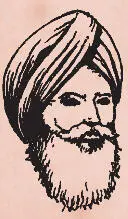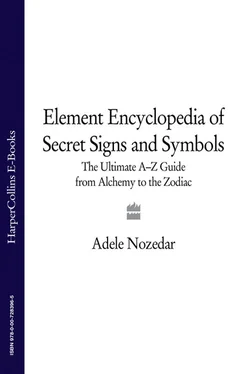Headgear immediately identifies the status of the owner. The crown, for example, is an immediate recognition of royalty. People in authority wear peaked hats. The beggar goes “cap in hand.” Additionally, headgear itself indicates a relationship with the divine, since the top of the head is effectively the first point of contact with the spirit that descends from above. The symbolic nature of headgear is altogether different from its practical usage. In temples, churches, and other holy places, the feet might be bare but the head is covered as a sign of modesty.

The open crown, coronet, tiara, or diadem has no practical secular purpose; indeed, the heavier crowns that belong to the sovereignty can be headachingly heavy. The crown is a circle, symbolizing the idea of immortality and eternity, but with the added dimension of a connection between the spiritual and material that is cemented by the ritual of coronation itself, which signifies a blessing, benediction, or union with the divine power that comes from above. Crowns traditionally feature jeweled “rays” signifying Sun beams, an allusion to illumination in all senses of the word.
For the Ancient Egyptians, only pharaohs and deities were permitted to wear the crown. The double crowns of the Pharaohs consisted of the white conical miter that represented Upper Egypt, surrounded by the red encasement of Lower Egypt. The serpent symbol called the Uraeus, again worn only by pharaohs, was incorporated into this sacred crown.
The pope wears a triple crown, or Triregnum ( see Papal symbols). The three parts symbolize different aspects of the Catholic faith and of the papal role.
The crown is not always made of princely materials. The crown of laurels is still given as a sign of victory, and for Romans, the highest accolade for a soldier was to be given a crown made of lowly grass. The Corona Graminea signified the ownership of the territory, the right to the land on which the victory had taken place.
The feathered headdresses of Native Americans not only signify the status of the wearer, but the feathers themselves signify the different qualities of the birds they belong to. The most valued of all is the eagle feather. These headdresses epitomize the crown as a Sun symbol.
Which single factor is shared by the old-fashioned policeman’s helmet from the UK, medieval Jewish hats, the papal Triregnum, and the traditional witch’s hat? They all have a tall, conical shape. This has the effect of making the wearer taller than anyone else, more noticeable, and therefore more authoritative. This kind of hat is also a phallic symbol. In addition, the hat of the witch or wizard contains the essence of her magical power in the form of a spiral of energy.
Orthodox Jews wear the skullcap (also known as yarmulke or kippah ) at all times; it is stated in the Torah that no man should walk more than four paces without the head being covered. This is because of the belief that the head should always be covered in the presence of God, and since God is omnipotent, then it makes sense that the yarmulke is worn at all times.
The yarmulke is not only a recognizable symbol of the faith, but covering the head is in itself a sign of respect for, and fear of, God. Many men also cover their heads for the same reasons.
Covering the head as a sign of respect for God is not restricted to the Jewish faith, although many people tend to restrict this practice to the times that they are actually in the place of worship.
The wearing of a hood is sometimes viewed with suspicion, because it masks the face of the wearer. Therefore, the hood is a symbol of invisibility, of disguise, of secrecy, and tends to have negative connotations because we assume that the wearer has reason to conceal him- or herself. The figure of Death, with its scythe, often wears a hood, alluding to the fact that no one knows what form death will take.
Like the hood, the helmet is a symbol of invisibility. It also denotes power and invulnerability. The Greek King of Hell, Hades, wears a helmet, and epitomizes all these powers. The covered-face helmet shares many of the same qualities as the mask.
The five Khalsas are the dress rituals of adherents to the Sikh faith, and signs by which they can be recognized. The five Khalsas are:
1 Kesa—this is uncut hair. The hair remains uncut as a reminder that harm must not be inflicted upon the body. Male Sikhs wear the turban as an article of faith, and it also makes a practical garment to cover and contain the hair.
2 Kacha—this is a particular kind of undergarment as a symbol of marital chastity. Men and women wear similar garments.
3 Kanga—a wooden comb, symbolizing tidiness and cleanliness.
4 Kara—a steel bangle, which serves as a reminder of the truth and of God.
5 Kirpan—a dagger, for ceremonial use only, and a reminder to protect those who need it.
The Khalsas are sometimes referred to as the Five Ks.
Nuns, monks, and priests of all persuasions wear the plain robes called “habits”. As well as acting as a kind of uniform, the habit also symbolizes the rejection of material values in favor of spiritual virtues. Generally colored gray or brown, the wearer no longer has to worry about a choice of clothes since external appearances do not matter. Effectively, the habit removes the individual personality. The sackcloth robes worn by ascetics are an extreme statement of the renunciation of worldly appearance, often worn as a penance.
Robes in general signify the rank of the wearer, and because they are distinctly different from everyday dress, they tend to be the preferred dress of spiritual or religious people. In China, the Imperial Robes were very ornate and carried specific symbolism as a part of their design. The round collar was the Heaven, the square hem, the Earth; the wearer of this robe was therefore an intermediary between the two. Latter-day druids of some orders wear green robes to signify the bardic grade, blue for the ovate grade, and the fully initiated druid wears white robes. Indeed, pilgrims of all faiths, including Buddhist, Muslim, and Shinto, wear white robes. Buddhist monks and followers of Hare Krishna wear robes of the sacred saffron color.
The robes of a shaman, like those of the wizard, are covered in magical signs. They are also decorated with feathers (symbolic of transcendence) and the pelt of the animal whose spirit they wish to connect with.
A shirt is a symbol of protection. To “lose one’s shirt” means to relinquish the last vestige of dignity as well as material wealth. However, to give “the shirt off your back” is a gesture of great generosity, indicating a willingness to give away the last of your material possessions. The “hair shirt” is an uncomfortable garment worn by penitents who want to self-inflict punishment.
The tunic is an earlier form of the shirt. The Cathars used it as an analogy for the human body. When they said that fallen angels wore tunics, they meant that they were made of flesh.
The veil symbolizes a distinct separation between two states of being, physical objects, or concepts. However, the object effecting this separation is apparently flimsy. It must be remembered that this is a two-way separation; the nun that “takes the veil” to become a Bride of Christ separates herself from the world, but also removes the worldly from her relationship with the spiritual.
Читать дальше













